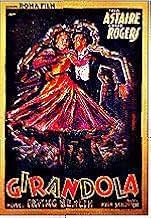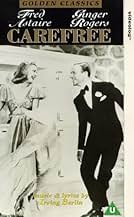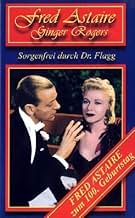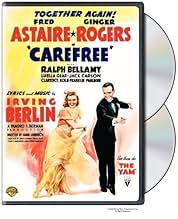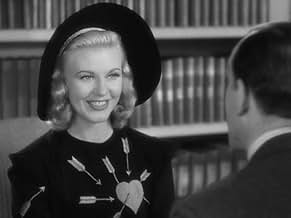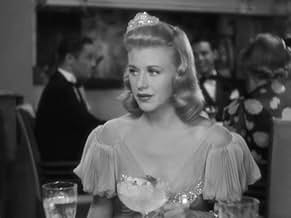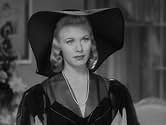CALIFICACIÓN DE IMDb
6.9/10
4.5 k
TU CALIFICACIÓN
Un psiquiatra se enamora de la mujer a la que supuestamente está empujando a casarse con otra persona.Un psiquiatra se enamora de la mujer a la que supuestamente está empujando a casarse con otra persona.Un psiquiatra se enamora de la mujer a la que supuestamente está empujando a casarse con otra persona.
- Dirección
- Guionistas
- Elenco
- Nominado a 3 premios Óscar
- 3 premios ganados y 4 nominaciones en total
The Robert Mitchell Boy Choir
- Vocal Ensemble
- (escenas eliminadas)
- (as Robert B. Mitchell and his St. Brendan's Boys)
Harry A. Bailey
- Sponsor
- (sin créditos)
Bobby Barber
- Minor Role
- (sin créditos)
Cliff Bergere
- Minor Role
- (sin créditos)
Ralph Brooks
- Country Club Guest
- (sin créditos)
James P. Burtis
- Glass Truck Driver
- (sin créditos)
Harry Campbell
- Minor Role
- (sin créditos)
James Carlisle
- Country Club Guest
- (sin créditos)
Charles Coleman
- Doorman
- (sin créditos)
Opiniones destacadas
If you attempt to look at the plot carefully (never a good idea in a musical) this is a rather repellent movie. The practice of Psychotherapy wasn't as well known or as well respected as it is today, and the film was clearly written by someone who seemed to think of it as some fad medical cure indulged in mainly by rich and foolish women. As such we get to see Fred Astaire, the therapist, subjecting Ginger Rogers, the patient, to all manner of barbaric (to modern eyes) treatments in order to find out why she won't marry his best friend. Eventually Astaire uses hypnosis to force her to marry him, and then force him not to. Clearly, movie doctors were not subjected to as severe a code of ethics as are real ones.
Its a pretty typical outing for Astaire and Rogers. Astaire's dancing is extraordinary (the dance scene on the golf course is great, as is the one where he dances with a hypnotized Rogers). Rogers' comic timing is, as always, wonderful. The secondary characters are all two-dimension cut-outs, but they're entertaining ones. If the characters didn't have quite the same sparkle to their interplay, remember, this was Astaire and Rogers' eighth film together and artistic differences were beginning to create a strain.
My biggest issue with this movie was the scene in which they sing the song "I Used To Be Colorblind". This was dream sequence, and it lasted about five minutes. "Carefree" is a black and white movie and the intent originally was to film the dream sequence in color a'la "Wizard of Oz". Apparently, somewhere in the production process, people balked at the cost and it was produced in black and white along with the rest of the film. Being filmed in black and white makes the song, and the entire sequence makes not one lick of sense, because the song is about how crisp and clear the world seems in color. Not only that, but since it was designed to be viewed on color film, not in black and white, the sets weren't designed with that same high degree of contrasts they would have if they had been designed to be viewed in black and white. As such, things in the dream sequence are LESS clear than in the rest of the movie, not more. I'm just appalled that the studio could spring for a few minutes of color footage for a film with such proved money-makes as Astaire and Rogers.
Its a pretty typical outing for Astaire and Rogers. Astaire's dancing is extraordinary (the dance scene on the golf course is great, as is the one where he dances with a hypnotized Rogers). Rogers' comic timing is, as always, wonderful. The secondary characters are all two-dimension cut-outs, but they're entertaining ones. If the characters didn't have quite the same sparkle to their interplay, remember, this was Astaire and Rogers' eighth film together and artistic differences were beginning to create a strain.
My biggest issue with this movie was the scene in which they sing the song "I Used To Be Colorblind". This was dream sequence, and it lasted about five minutes. "Carefree" is a black and white movie and the intent originally was to film the dream sequence in color a'la "Wizard of Oz". Apparently, somewhere in the production process, people balked at the cost and it was produced in black and white along with the rest of the film. Being filmed in black and white makes the song, and the entire sequence makes not one lick of sense, because the song is about how crisp and clear the world seems in color. Not only that, but since it was designed to be viewed on color film, not in black and white, the sets weren't designed with that same high degree of contrasts they would have if they had been designed to be viewed in black and white. As such, things in the dream sequence are LESS clear than in the rest of the movie, not more. I'm just appalled that the studio could spring for a few minutes of color footage for a film with such proved money-makes as Astaire and Rogers.
Tony Flagg (Fred Astaire) agrees to psychoanalyze the girlfriend of his pal Steve (Ralph Bellamy) because she can't make up her mind as to whether or not she wants to marry him. The girlfriend, Amanda (Ginger Rogers), decides in short order that she actually loves Tony, but he has decided she's perfectly normal and doesn't need his help. So she contrives a ridiculous dream so that he thinks she is abnormal and will continue to treat her.
This film should have been renamed "Conscience Free" as none of the three central players seems to have one. Astaire comically abuses his license to heal to hypnotize Rogers to try to control her emotions. When he realizes he's fallen for her, he tries to re-direct her affections for Bellamy to him. Rogers, when told under hypnosis to follow every impulse, escapes Astaire's office before she can be taken out of her trance, decides it would be fun to knock the canes away from old people and watch them fall down and to throw rocks through windows. And Bellamy, upon hearing that Rogers really loves Astaire, and that she is only marrying him as a result of hypnosis, is perfectly OK with that.
The Irving Berlin music, what there is of it, is fine. But there is little of the usual chemistry between Astaire and Rogers. Bright spots include an early career appearance by Jack Carson showing his flair for comedy and Clarence Kolb as a family friend and judge acting like The Monopoly Man personified. This was the only Astaire & Rogers film to lose money at the box office.
This film should have been renamed "Conscience Free" as none of the three central players seems to have one. Astaire comically abuses his license to heal to hypnotize Rogers to try to control her emotions. When he realizes he's fallen for her, he tries to re-direct her affections for Bellamy to him. Rogers, when told under hypnosis to follow every impulse, escapes Astaire's office before she can be taken out of her trance, decides it would be fun to knock the canes away from old people and watch them fall down and to throw rocks through windows. And Bellamy, upon hearing that Rogers really loves Astaire, and that she is only marrying him as a result of hypnosis, is perfectly OK with that.
The Irving Berlin music, what there is of it, is fine. But there is little of the usual chemistry between Astaire and Rogers. Bright spots include an early career appearance by Jack Carson showing his flair for comedy and Clarence Kolb as a family friend and judge acting like The Monopoly Man personified. This was the only Astaire & Rogers film to lose money at the box office.
there is something specific about watching fred astaire and ginger rogers that just makes you want to dance. i think it's because they make it look so damn fun. and they are just so astonishingly good!! the plot here is a tad crazier than, say "top hat", and therefore that much less believable (come on ... going all out with freud and hypnosis, but then again that's just speaking from what is known today, so no problem letting that pass). irving berlin's music is a hoot at times (there's a song about yams) and classic and familiar at others ("change partners") and ginger rogers is nearly at her sassy best.
this is one of my favorite fred astaire/ginger rogers films. it's highly amusing how she toys with him at the beginning of the film, and then once he begins hypnosis, they have one of the best dance scenes i've ever seen between them. as always, their magic together is astounding.
The upper-class Stephen Arden (Ralph Bellamy) brings his fiancée, the radio singer Amanda Cooper (Ginger Rogers), to be consulted by his friend, the psychoanalyst Dr. Tony Flagg (Fred Astaire), to improve their relationship. Amanda listens to the record made by Dr. Flagg about her and has an initial friction with the shrink. But sooner she falls in love with him and discloses her feelings to Dr. Flagg. He decides to hypnotize Amanda to loath him and love Stephen. However his subconscious makes him perceive that he also loves Amanda. But Stephen obtains a restrain order against his friend and he can not get close to Amanda to withdrawal his former hypnotic suggestion.
"Carefree" is a delightfully naive and adorable classic, with a silly story but wonderful dance numbers of the constant pair Fred Astaire and Ginger Rogers. Ginger "steals" the film not only dancing, but also with a funny performance. My vote is seven.
Title (Brazil): "Dance Comigo" ("Dance with Me")
"Carefree" is a delightfully naive and adorable classic, with a silly story but wonderful dance numbers of the constant pair Fred Astaire and Ginger Rogers. Ginger "steals" the film not only dancing, but also with a funny performance. My vote is seven.
Title (Brazil): "Dance Comigo" ("Dance with Me")
¿Sabías que…?
- TriviaThis was the first Fred Astaire-Ginger Rogers film to lose money on its initial release. It lost $68,000 (~ $1.48M in 2024) for RKO according to studio records.
- ErroresAs Amanda (Ginger Rogers) exits the taxicab and starts to cross the street for the theatre, you can see the reflection of the roof line behind her in the large piece of plate glass on the truck. On the roof line, you can see the rigging pipes for lights and other equipment showing it's a back lot set.
- Citas
Stephen Arden: [drunkenly] Oh, uh, could you give me a little information?
Doorman: Yes sir.
Stephen Arden: Thank you.
[walks away]
- Créditos curiososDuring opening credits, a pair of hands finger-paints names, pauses, wipes them out, and writes the next set of names several times.
- ConexionesFeatured in Fred Astaire: Puttin' on His Top Hat (1980)
- Bandas sonorasSince They Turned Loch Lomond into Swing
(1938) (uncredited)
Music by Irving Berlin
Danced by Fred Astaire
Selecciones populares
Inicia sesión para calificar y agrega a la lista de videos para obtener recomendaciones personalizadas
- How long is Carefree?Con tecnología de Alexa
Detalles
Taquilla
- Presupuesto
- USD 1,253,000 (estimado)
- Tiempo de ejecución1 hora 23 minutos
- Color
- Relación de aspecto
- 1.37 : 1
Contribuir a esta página
Sugiere una edición o agrega el contenido que falta

